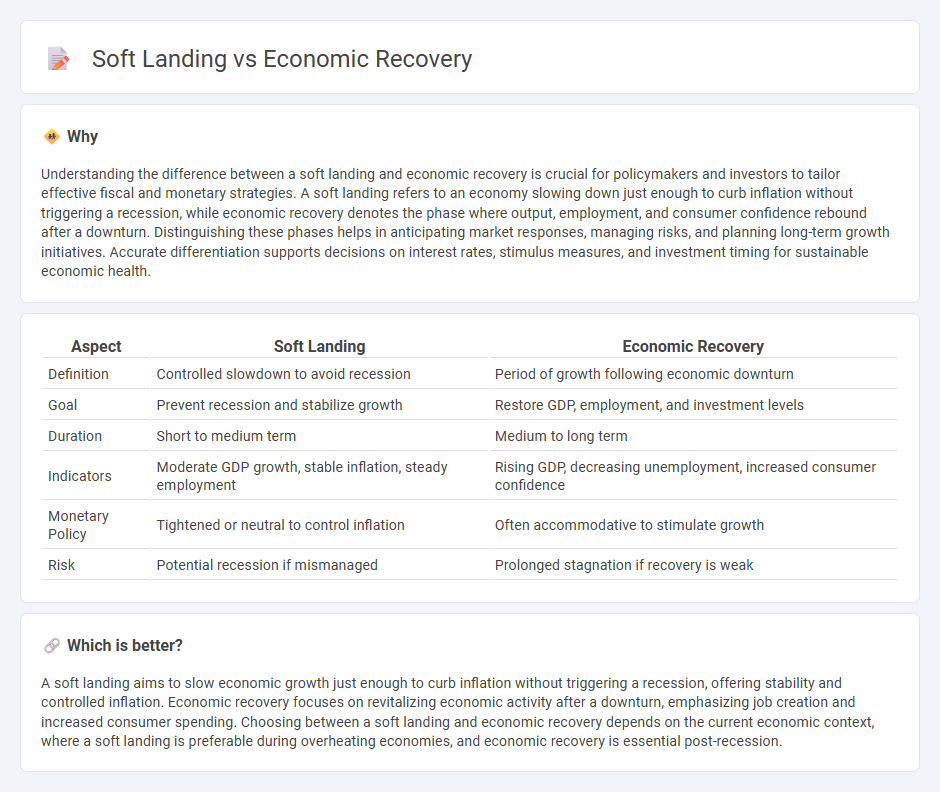
Soft landing refers to a strategy where economic growth slows gradually to avoid recession while maintaining stable employment and inflation rates. Economic recovery, on the other hand, involves a significant rebound in economic activity following a downturn or recession, marked by rising GDP, improved consumer confidence, and increased investment. Explore the key differences and strategies behind soft landings and economic recoveries to understand their impact on market stability.
Why it is important
Understanding the difference between a soft landing and economic recovery is crucial for policymakers and investors to tailor effective fiscal and monetary strategies. A soft landing refers to an economy slowing down just enough to curb inflation without triggering a recession, while economic recovery denotes the phase where output, employment, and consumer confidence rebound after a downturn. Distinguishing these phases helps in anticipating market responses, managing risks, and planning long-term growth initiatives. Accurate differentiation supports decisions on interest rates, stimulus measures, and investment timing for sustainable economic health.
Comparison Table
| Aspect | Soft Landing | Economic Recovery |
|---|---|---|
| Definition | Controlled slowdown to avoid recession | Period of growth following economic downturn |
| Goal | Prevent recession and stabilize growth | Restore GDP, employment, and investment levels |
| Duration | Short to medium term | Medium to long term |
| Indicators | Moderate GDP growth, stable inflation, steady employment | Rising GDP, decreasing unemployment, increased consumer confidence |
| Monetary Policy | Tightened or neutral to control inflation | Often accommodative to stimulate growth |
| Risk | Potential recession if mismanaged | Prolonged stagnation if recovery is weak |
Which is better?
A soft landing aims to slow economic growth just enough to curb inflation without triggering a recession, offering stability and controlled inflation. Economic recovery focuses on revitalizing economic activity after a downturn, emphasizing job creation and increased consumer spending. Choosing between a soft landing and economic recovery depends on the current economic context, where a soft landing is preferable during overheating economies, and economic recovery is essential post-recession.
Connection
A soft landing in the economy occurs when growth slows just enough to prevent overheating without causing a recession, creating favorable conditions for sustained economic recovery. This controlled deceleration helps maintain employment levels and consumer confidence, which are critical for revitalizing investment and spending. Efficient monetary and fiscal policies play a pivotal role in achieving a soft landing that supports long-term economic stabilization.
Key Terms
GDP Growth
Economic recovery refers to the phase where GDP growth rebounds following a recession or economic downturn, driven by increased consumer spending, investment, and government stimulus. Soft landing describes a scenario where GDP growth slows down to a sustainable rate without triggering a recession, often achieved through careful monetary policies and inflation control. Explore further to understand how these concepts influence fiscal strategies and market behavior.
Inflation Rate
Economic recovery often features a declining inflation rate as demand stabilizes and supply chains normalize, whereas a soft landing aims to moderate inflation without triggering recession through controlled monetary policies. Inflation rate management is critical in distinguishing these outcomes, with central banks closely monitoring consumer price indexes and wage growth to calibrate interest rates. Explore in-depth how inflation trends influence the success of economic recovery and soft landing strategies.
Unemployment Rate
The unemployment rate serves as a critical indicator distinguishing economic recovery from a soft landing, where a recovery typically shows a marked decline in unemployment as business activity accelerates, while a soft landing aims to moderate this decline to prevent overheating and inflation. Economic recovery periods often reflect a rapid drop in unemployment, sometimes exceeding pre-recession levels, signaling robust job creation and economic expansion. Explore how fluctuations in the unemployment rate impact policy decisions and economic forecasting for a deeper understanding.
Source and External Links
Economic recovery - Wikipedia - Economic recovery is the phase of the business cycle following a recession, characterized by renewed growth, re-employment of resources, and adaptation to new economic circumstances, often requiring transformative reforms rather than simply returning to pre-recession conditions.
Measuring economic recovery | National Association of Counties - Economic recovery involves multiple facets, including labor market rebound, business and production resumption, service sector normalization, and consumer spending revival, with recovery rates varying by industry and often linked to public health milestones like vaccination rates.
Economic Recovery Corps: Home - The Economic Recovery Corps is a collaborative initiative aimed at accelerating recovery from economic crises, especially in distressed communities, by empowering local organizations and fostering innovation and entrepreneurship.
 dowidth.com
dowidth.com